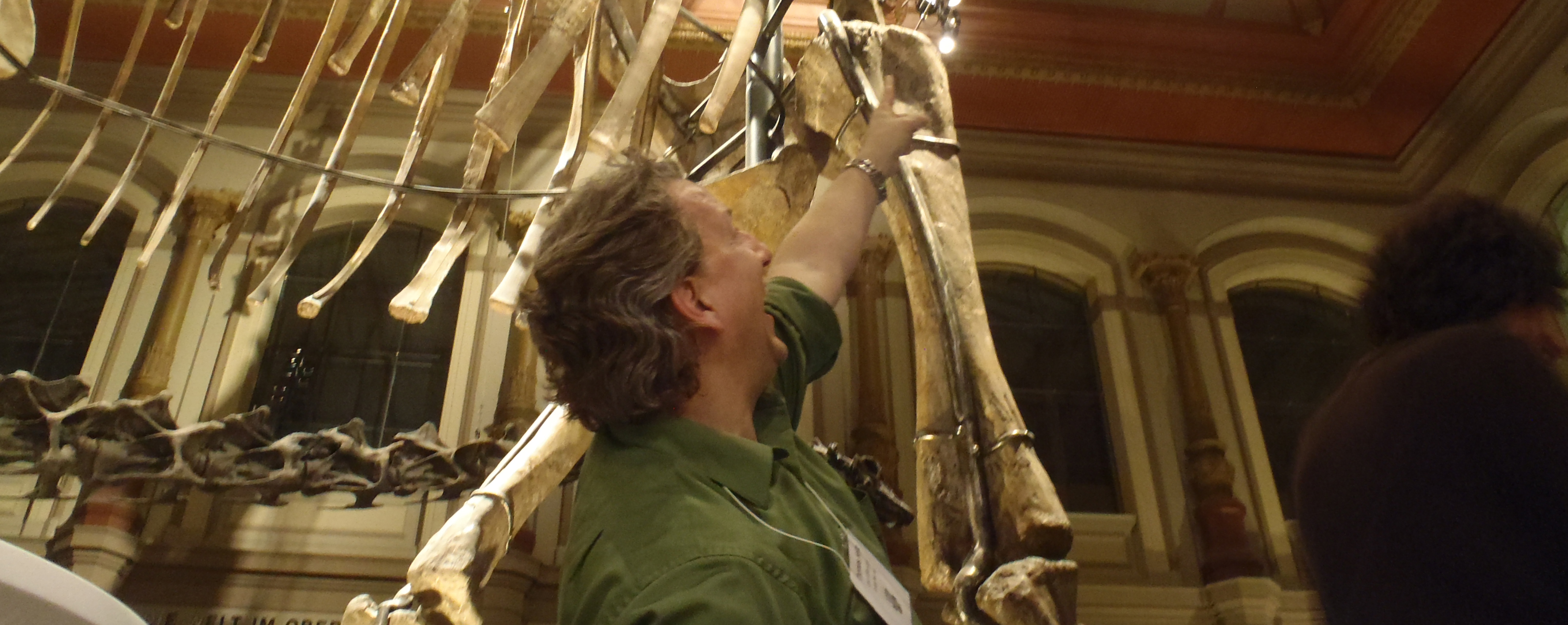

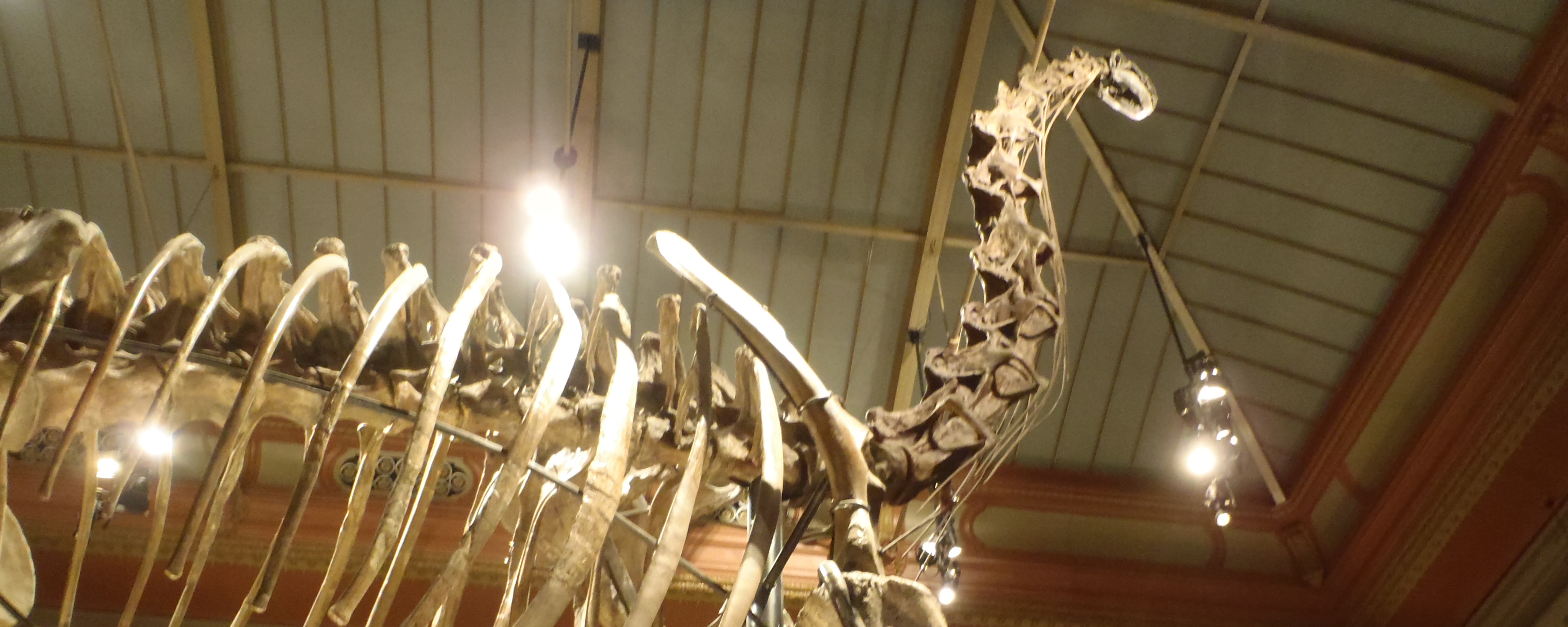
"The combination of such characters, some, as the sacral ones, altogether peculiar among Reptiles, others borrowed, as it were, from groups now distinct from each other, and all manifested by creatures far surpassing in size the largest existing reptiles, will, it be presumed, be deemed sufficient ground for establishing a distinct tribe or sub-order of Saurian Reptiles, for which I would propose the name of Dinosauria." -- Sir Richard Owen, 1842, "British Fossil Reptiles"
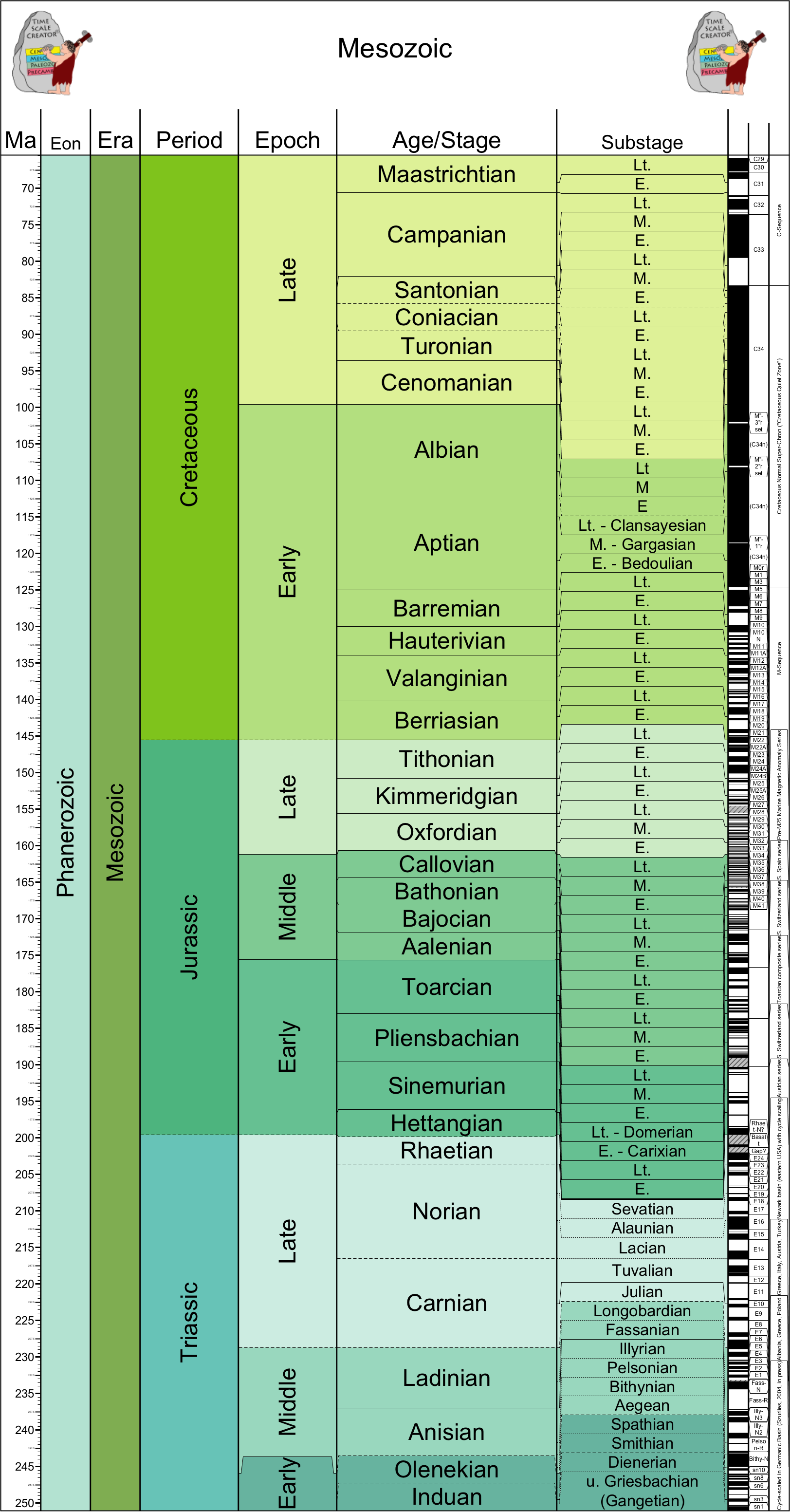
BIG QUESTION: How did (some) dinosaurs get so big?
Discovery of the Age of Reptiles
During the late 18th and early 19th Century paleontologists had discovered numerous fossil reptiles from what was then the "Secondary" Era (Mesozoic by today's standards). These included mosasaurs, ichthyosaurs, and plesiosaurs (all marine reptiles) and pterosaurs (flying reptiles). It became clear that there was no major presence of large bodied mammals in air or sea at this time, unlike as in the Cenozoic.
In the early 19th Century, a series of discoveries in England demonstrated the existence of large terrestrial animals during this "Age of Reptiles": carnivorous Megalosaurus and herbivorous Iguanodon. Although only known from fragmentary skeletons, they indicated the presence of giant land lizard-like animals. In 1842, paleontologist united these two and armored Hylaeosaurus as the Dinosauria (Latinized Greek for "fearfully great lizards"), distinct from all other living and extinct reptiles from their fully upright hindlimbs (more like a mammal than a lizard or crocodilian) and their large size (see quote at top).
Subsequent discoveries from all over the world revealed an astonishing diversity of form among the dinosaurs. Some of these included the largest land-dwelling animals of all time, with masses of about 100 tons; others were much, much smaller.
The present definition of Dinosauria is "the clade comprised of Iguanodon, Megalosaurus, Diplodocus, their concestor, and all of its descendants". This definition doesn't require dinosaurs to be big, scaly, land-dwelling, or extinct: in fact, as we will see, there are dinosaurs that are none of these.
Dinosaurs are a subdivision of the Archosauria, which is itself a subdivision of diapsid reptiles:
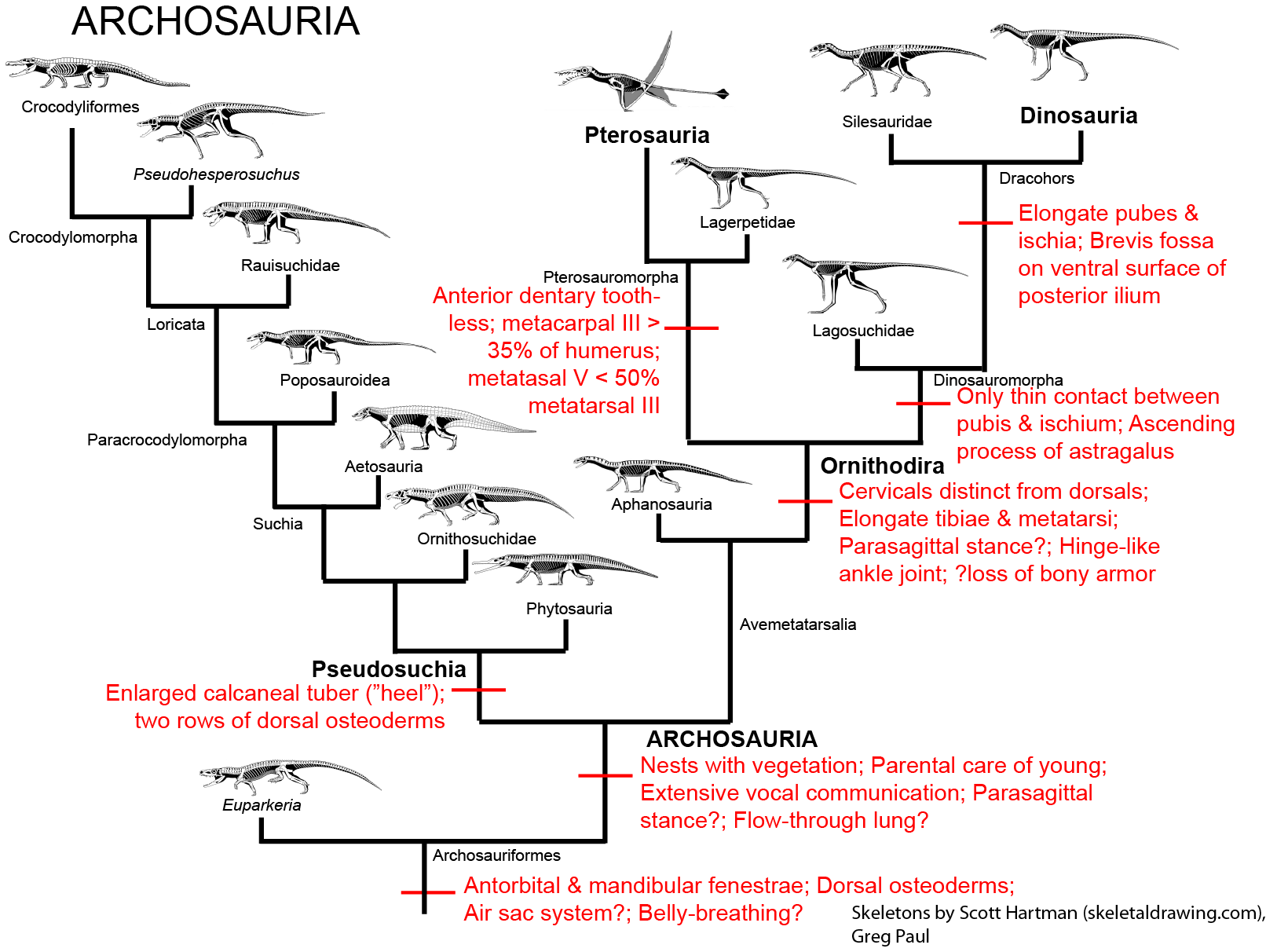
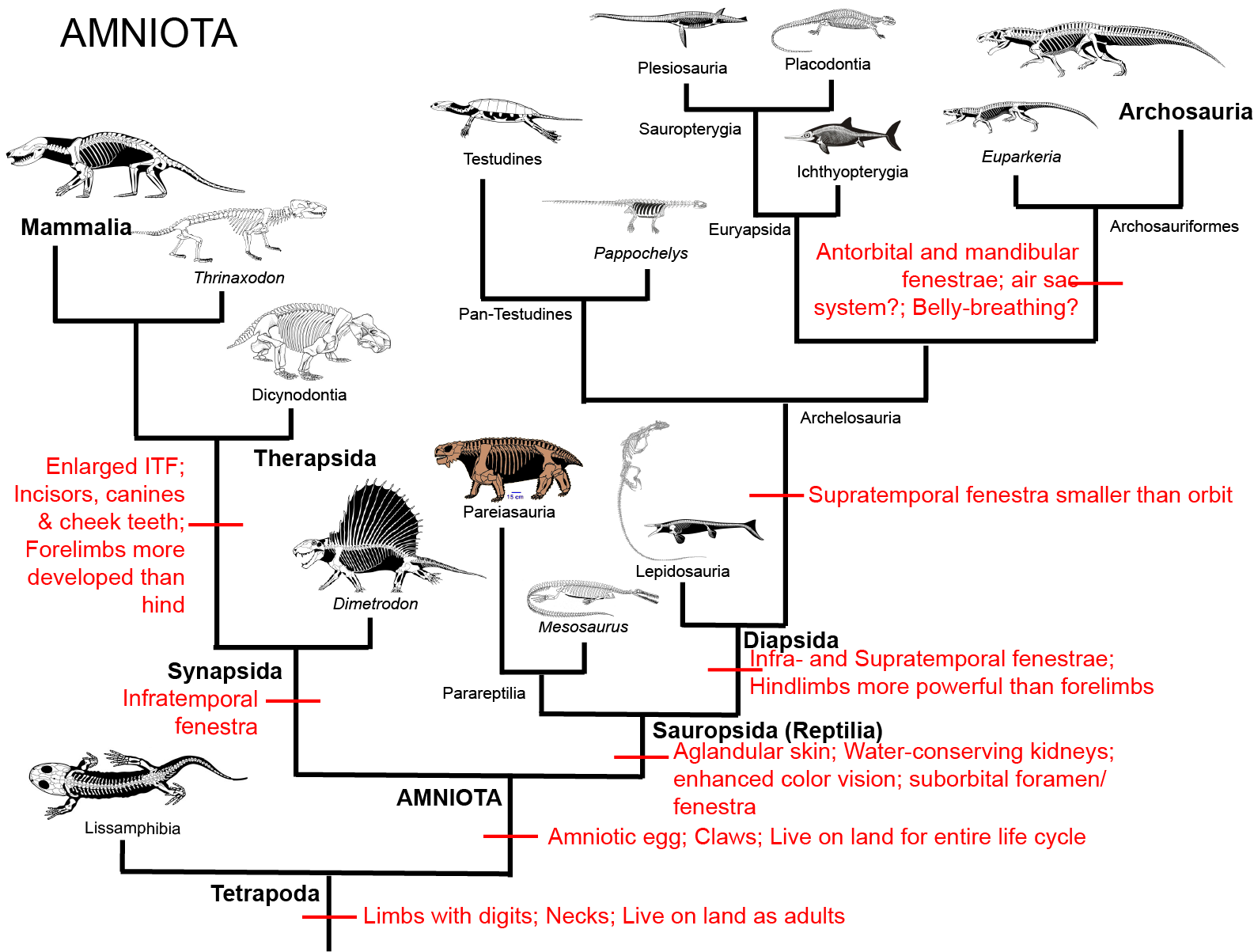
Terrestrial communities of the Middle and Late Permian were dominated by therapsids (stem-mammals), with reptiles as minot parts of the fauna. After the Permian/Triassic extinction therapsids remained dominant for the first few million years during the recovery fauna, but were quickly displaced by archosaurs.
The Pseudosuchia (crocodilians and all taxa closer to crocodilians than to birds) were the dominant group during most of the Triassic. They included such forms as:
In the shadow of the pseudosuchians, their sister group Ornithodira was present as rare forms. Initially quite small, ornithodirans are characterized by neck vertebrae distinct from the back vertebrae, and elongated lower leg bones. Among the ornithodirans are two main branches: Pterosauria and Dinosauromorpha. Dinosauromorphs are characterized by the parasagittal stance with a simple hinge-like ankle joint and a digitigrade stance (that is, they walked on the balls of their feet).
Footprint evidence shows that dinosauromorphs were present within the first few million years of the Early Triassic, and body fossils during the Middle Triassic. The recently-discovered Silesauridae represents the (at least at present) closest known dinosauromorphs to Dinosauria proper.
Dinosauria first appears at the beginning of the Late Triassic (c. 230 Ma). Dinosaurs divide into three major clades:
Prior to March 2017, 130 years of research and 35 years of phylogenetic analyses supported uniting Sauropodomorpha and Theropoda into Saurischia:
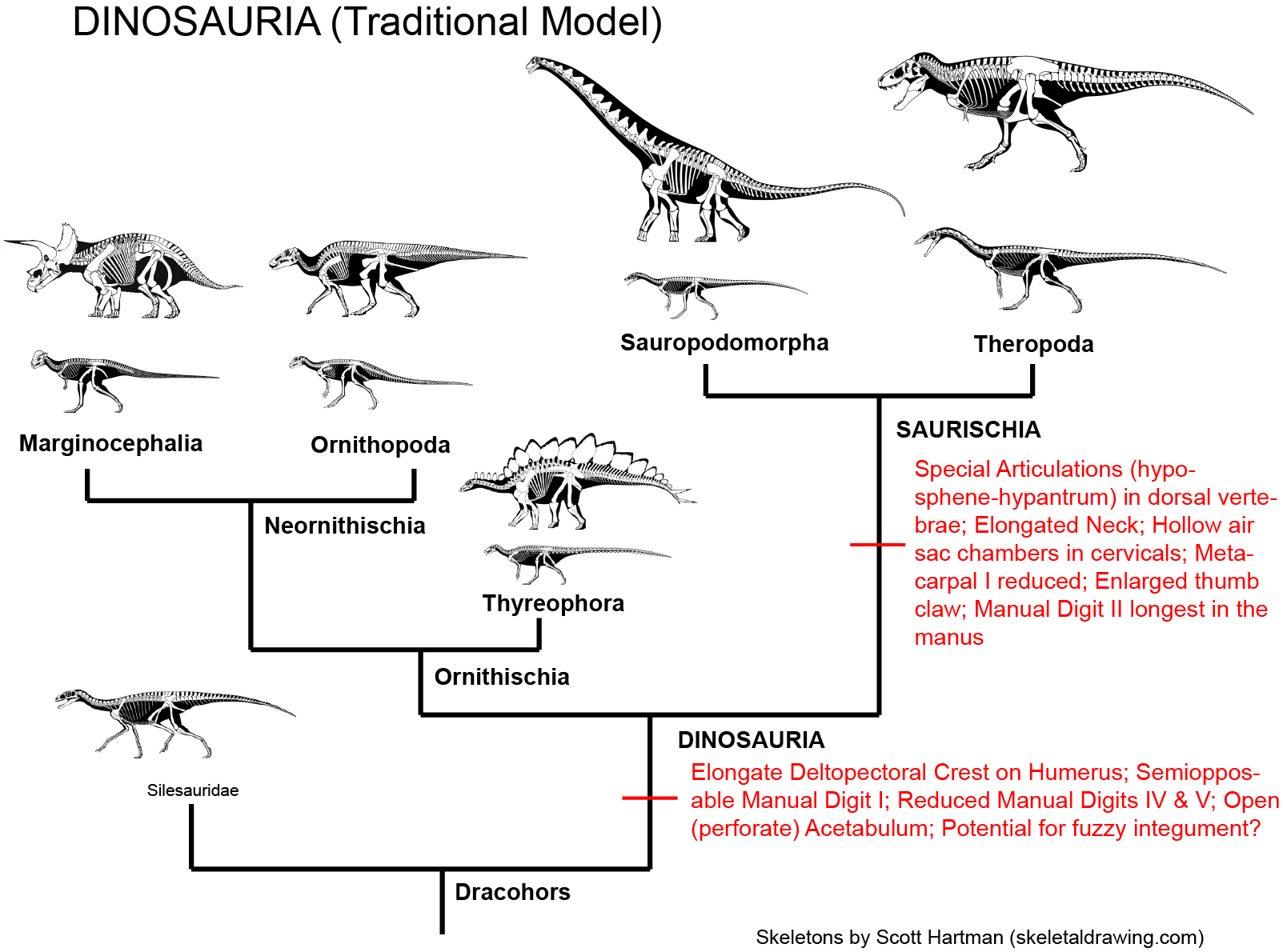
While this is still a distinct possibility, a recent study suggested alternatively that Ornithischia and Theropoda were sister taxa, making "Saurischia" paraphyletic. And there are some traits that have suggested that sauropodomorphs and ornithischians are closer to each other than either are to theropods (but to be fair no numerical cladistic analysis has yet produced this as the most parsimonious result). Here are these alternatives:
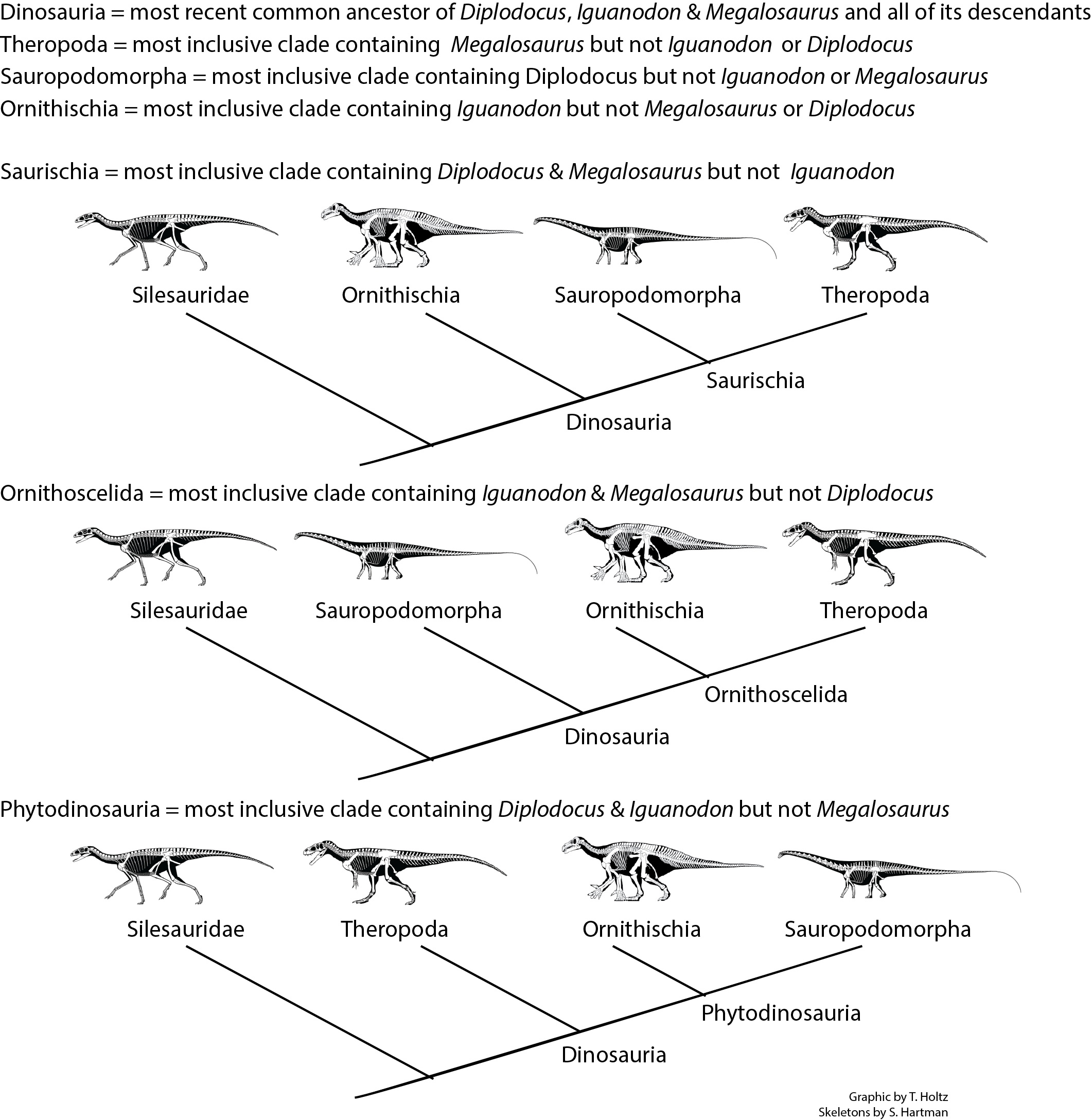
During the Triassic ornithischians were extremely rare and theropods were only secondary predators compared to the pseudosuchians. But sauropodomorphs were far more successful: starting at a mere 1-1.5 m long, they grow to 10 m by the end of the Triassic. Their success was likely due to the fact that they could feed high in the trees, unlike other contemporary herbivores.
Triassic pseudosuchians were more diverse in terms of morphology and more speciose than ornithodirans at this time. However, when the Triassic/Jurassic extinction occurred very few of the pseudosuchians survived (only small-bodied ancestors of the crocodilians). Additionally, the therapsids survived only in the form of early mammals, 5-10 cm. In contrast, the dinosaurs did much better. At the dawn of the Jurassic, dinosaurs were the dominant group of terrestrial animals, and underwent a major adaptive radiation.
Among the many diverse forms of Ornithischia:
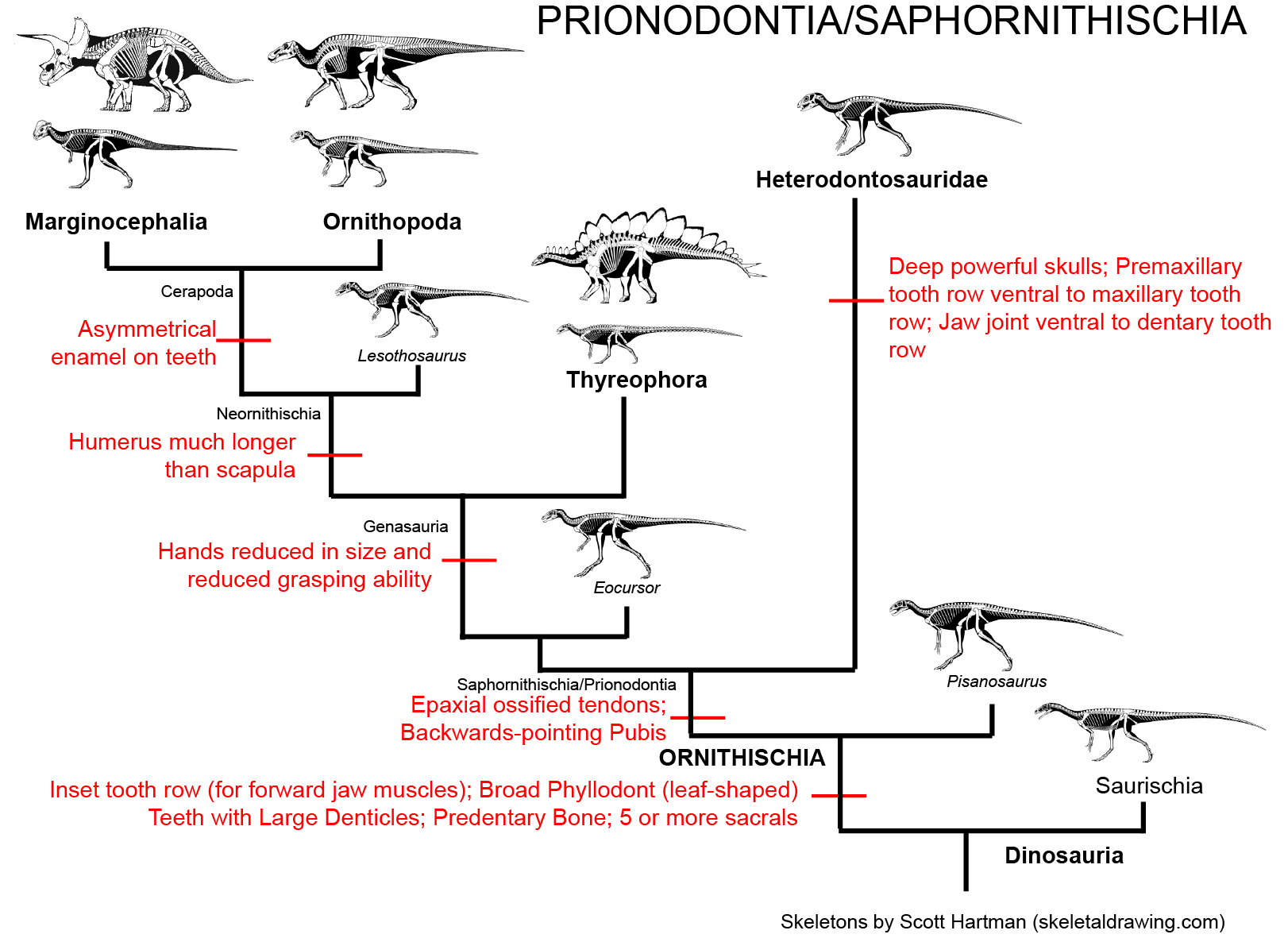
were the armored Thyreophora:
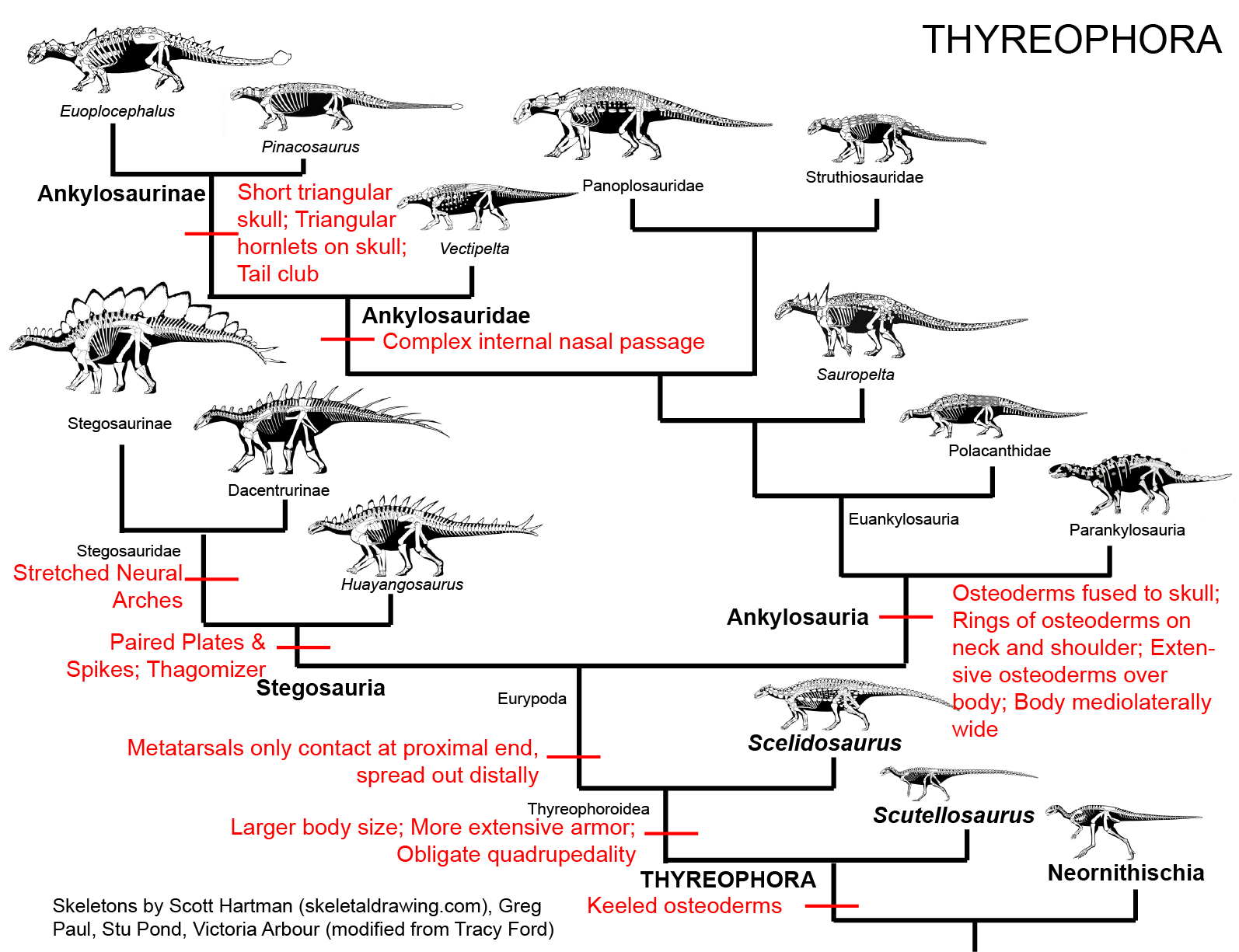
the beaked Ornithopoda:
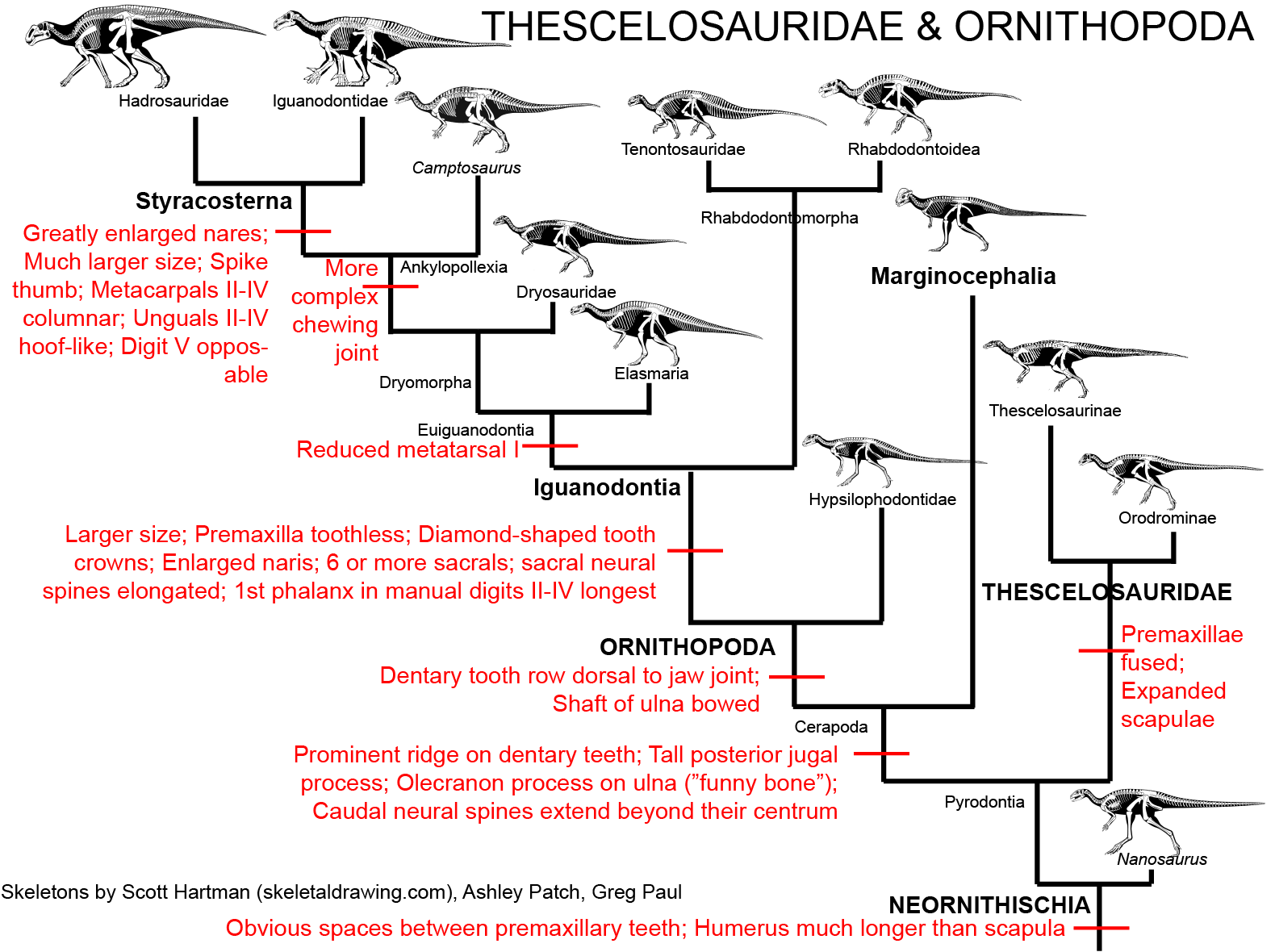
(including the highly derived duckbilled Hadrosauridae (or "duckbills")):
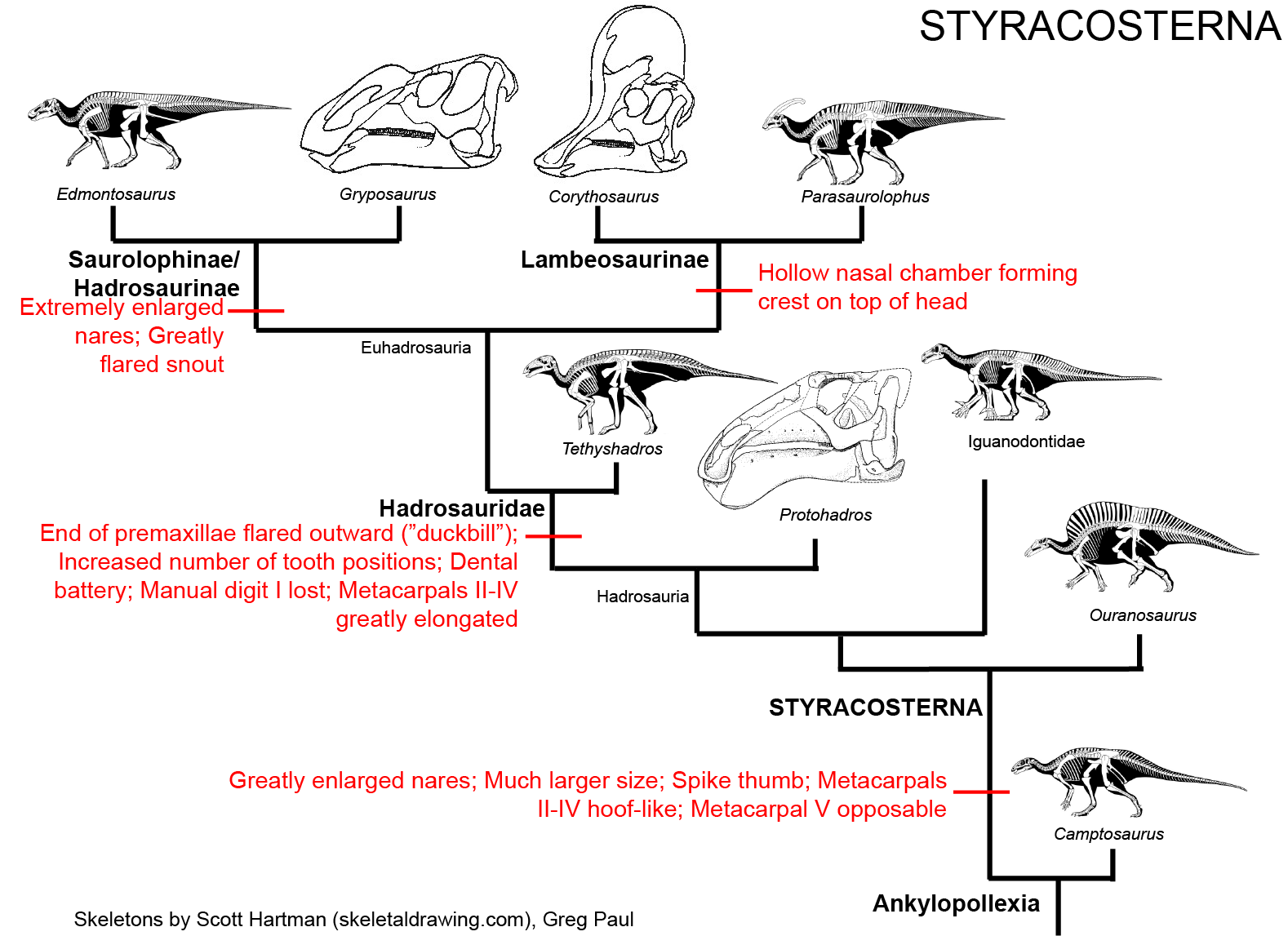
and the ridge-headed Marginocephalia:
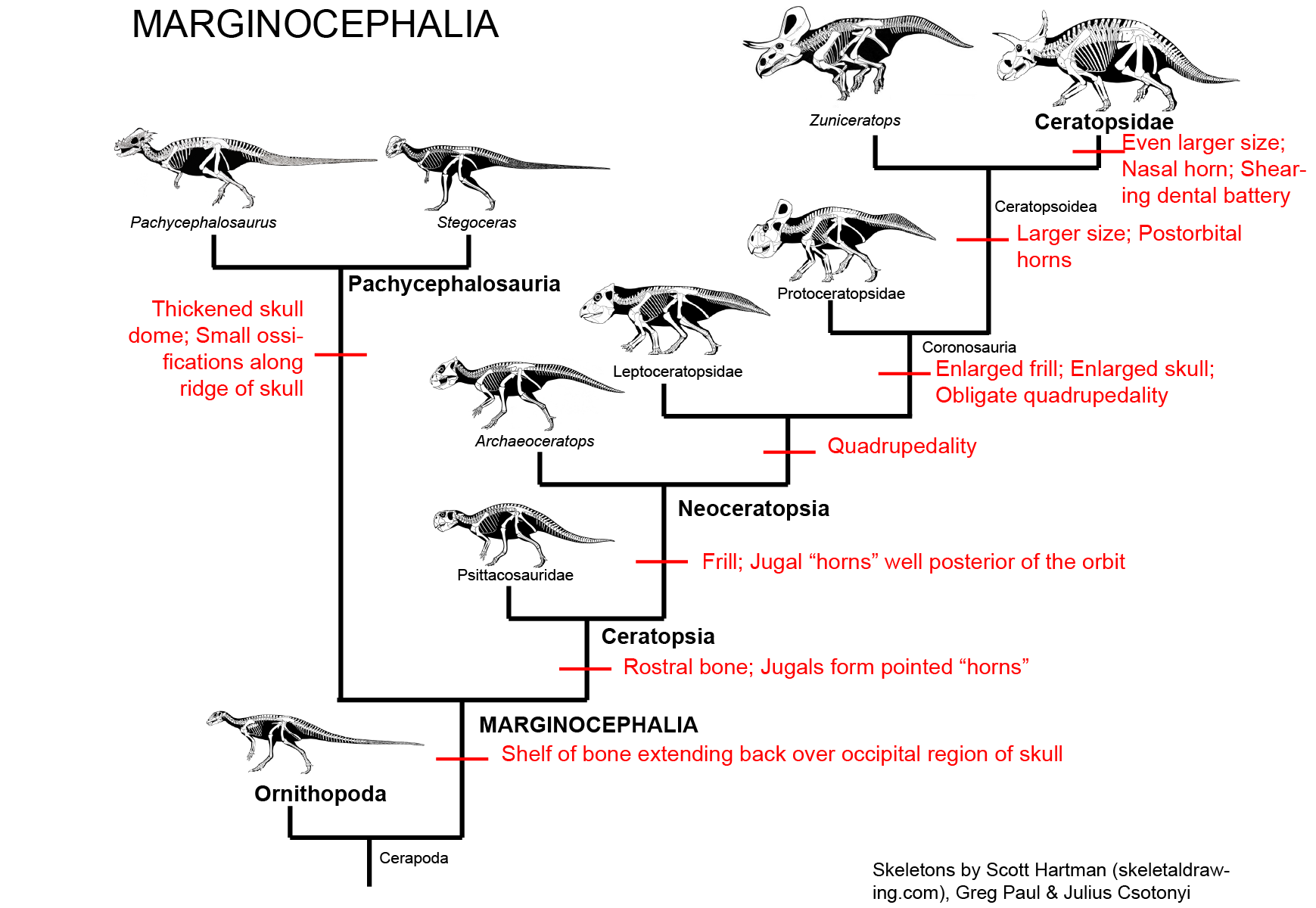
(including the specialized horned Ceratopsidae):
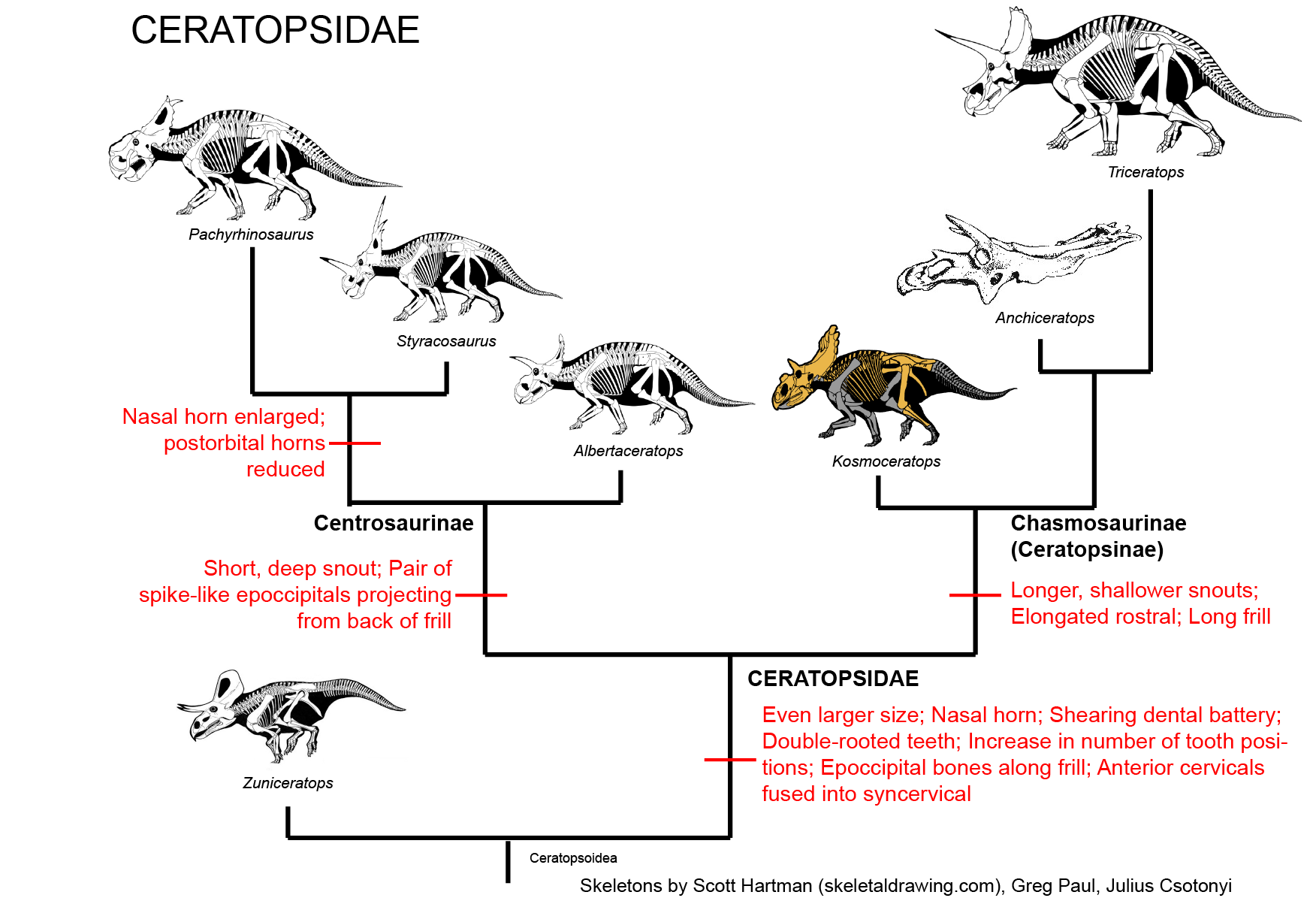
Among the various clades of Saurischia were the elongate-necked Sauropodomorpha:
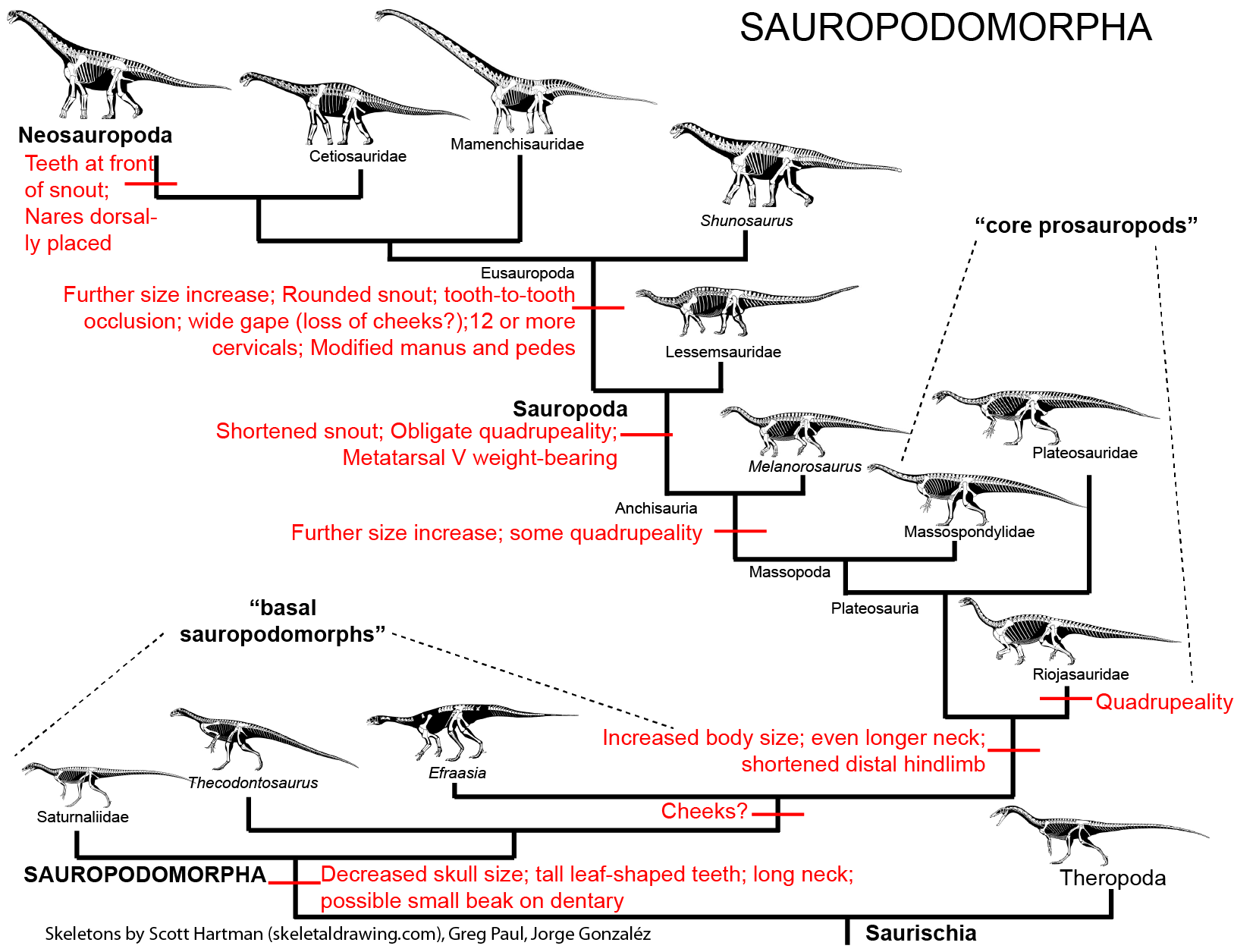
(including the Sauropoda, the largest land-animals of all):
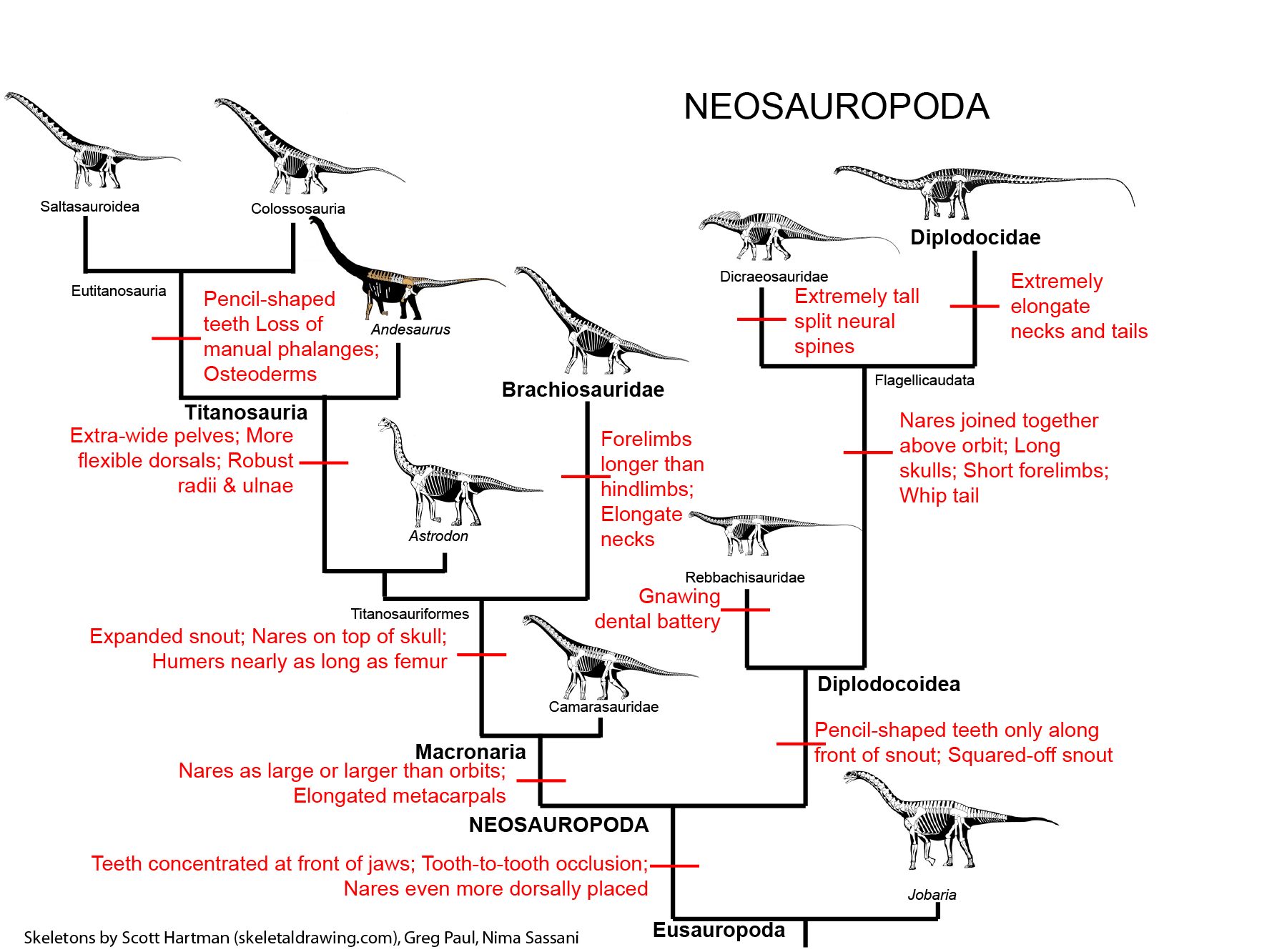
And the various subdivisions of Theropoda, from primitive stages:
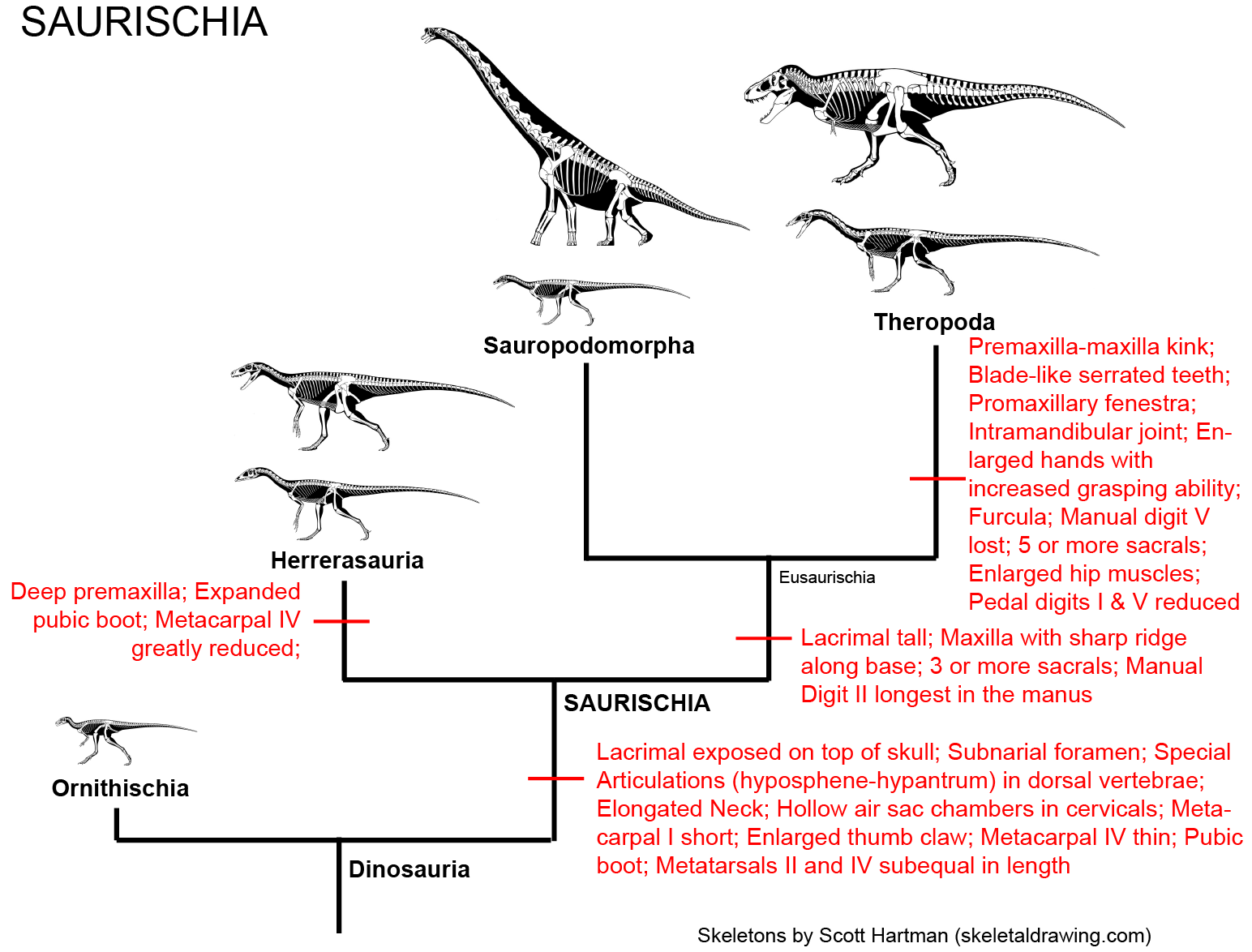
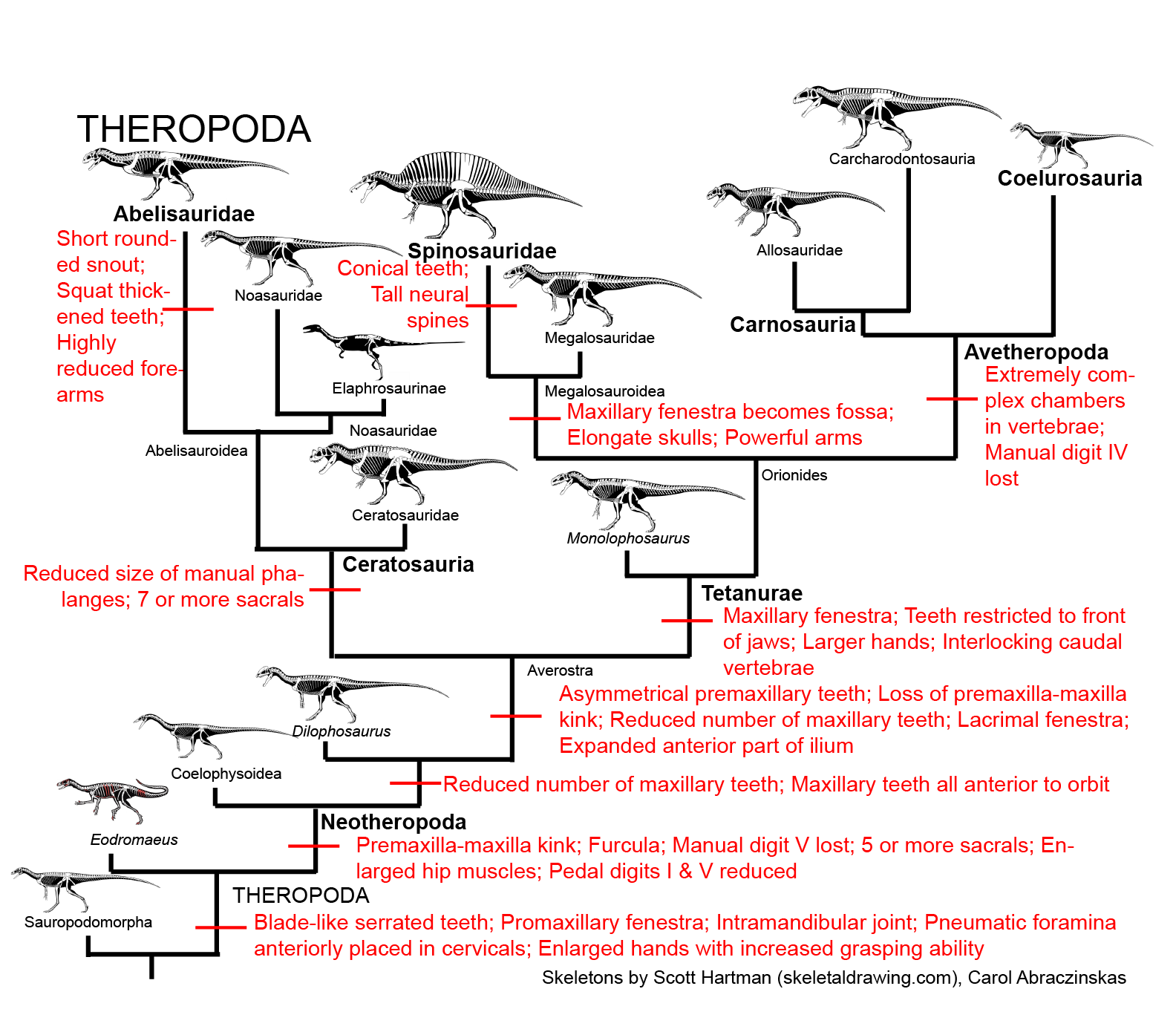
and the specialized feathered Coelurosauria, some of which were giant predators but many of which had shifted from eating meat to eating plants, insects, and the like:
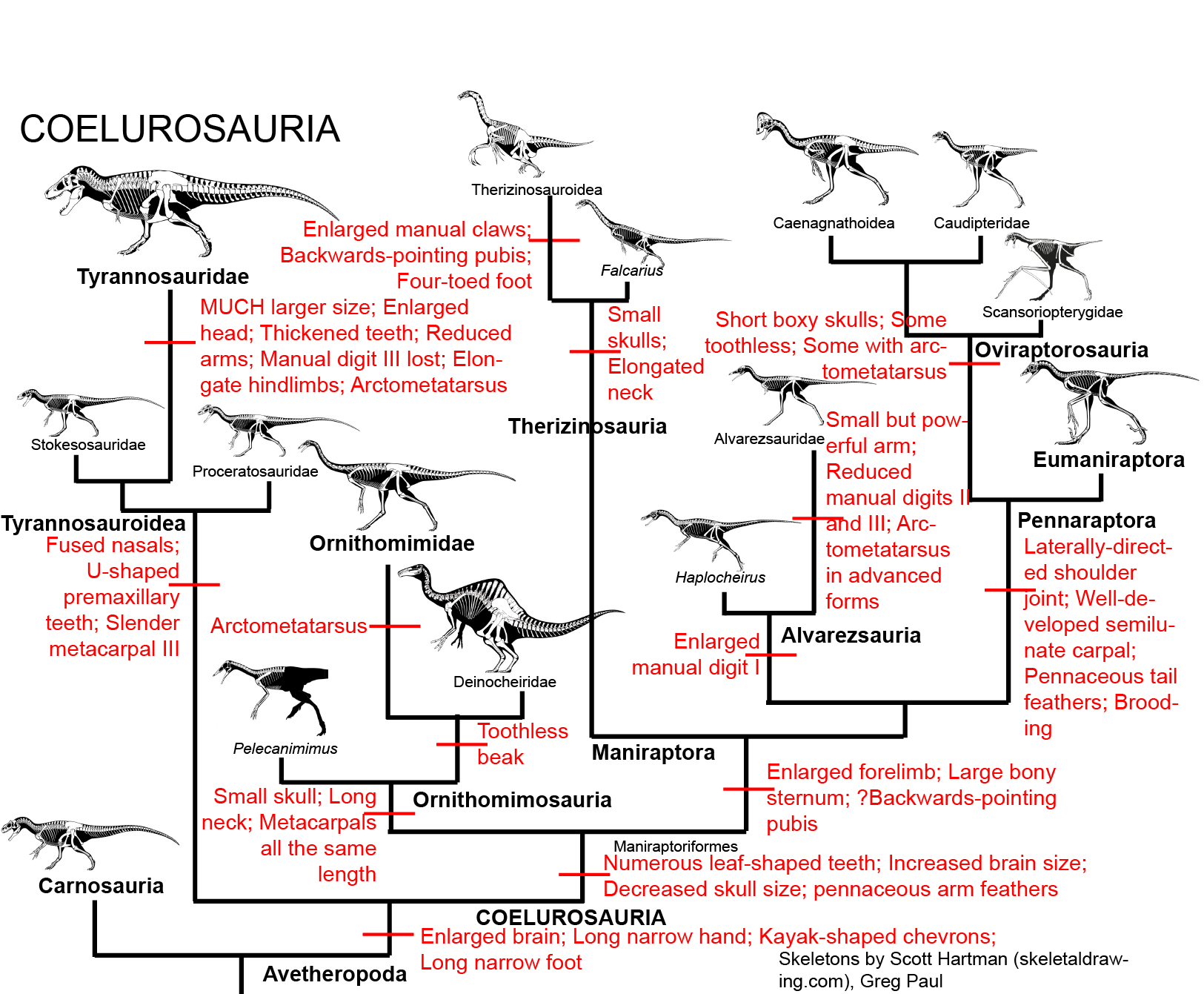
Among the most derived of the coelurosaurs were the Dromaeosauridae and Troodontidae (sometimes regarded as a single clade Deinonychosauria ("raptors")) and their sister group Avialae, or birds:
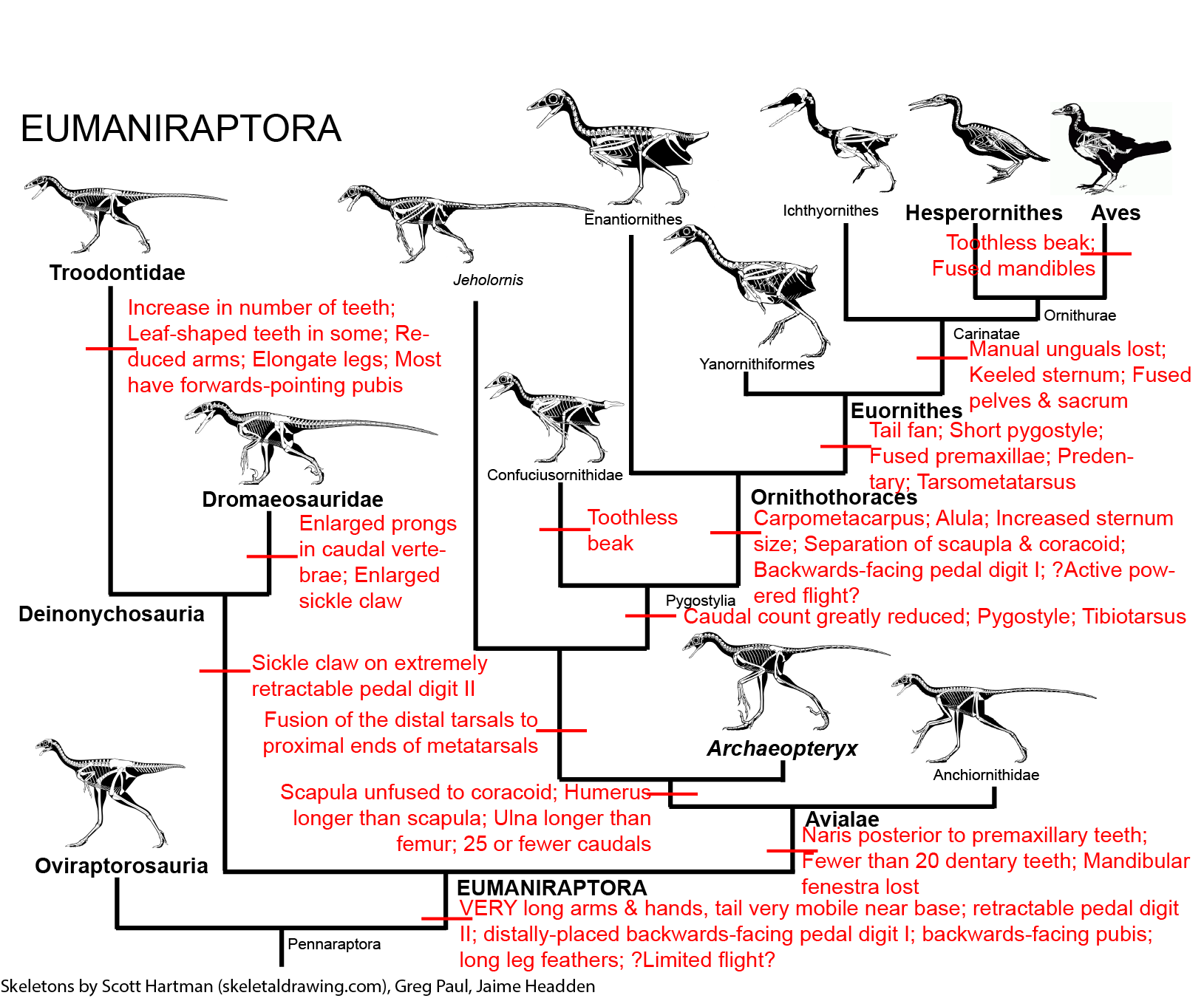
Yes, cladistically, all birds living and extinct are a type of dinosaur!
It isn't just that some dinosaurs were large. It is that giant (>1 t) size is fairly common in dinosaur groups, and that >5 t size occurs in both carnivorous and ornithischian dinosaurs (with many independent cases), and that >10 t is actually a STANDARD body size for the sauropod dinosaurs! Indeed, the very largest dinosaurs reached masses of 80-100 t (or, in other words, the mass of a herds of elephants!). In contrast, where there have been a few 10 t land mammals, most mammals were much smaller. (Of course, even dinosaurs were dwarfed by the modern blue whale). So how did dinosaurs get so big?
As with models of mass extinction, there are lots of unsupported, less-than-reasonable, pseudoscientific explanations:
So, let's take a look at other possibilities.
Was It Limb Posture (i.e., the Parasaggital Stance)? It is true that all the supergiant land animals (dinosaurs, elephants, deinotheres, indricothere rhinos, etc.) all have an upright stance. While there are giant 10-15 t crocodilians contemporaneous with and after the Age of Dinosaurs, these semi-upright animals were primarily aquatic and in a sense don't count.
But other groups with parasaggital stance--such as most pseudosuchians, marsupial mammals, modern birds, etc.--never reach these sizes. So it might be that a parasaggital stance is necessary but not sufficient for the >10 t size.
Was It From a REEAALLLLYYYYY LOOOOONNNNNGGGGG Period of Growth? Giant tortoises and big modern crocodilians live a very long time (centuries in the case of tortoises), growing throughout their life. Perhaps dinosaurs just grew for a tremendously long time? Let's take a look.
Dinosaurs went through a tremendous size increase over their life. No Mesozoic dinosaur egg has been found greater than 4 liters volume. Thus, even dinosaurs as massive as a herd of elephants arise from babies that fit inside a soccer ball.
How long did a dinosaur take to grow from tiny baby to giant adult? In the 20th Century, some researchers suggested that they grew rapidly, like mammals and birds. However, others thought that they grew more slowly like crocodilians, lizards and snakes, and turtles. (In fact, some tortoises have lifespans of centuries and it takes them many, many decades to reach sexual maturity.) Since the late 1990s a series of methods were developed to help resolve this.
Like many animals, dinosaurs deposited Lines of Arrested Growth (LAGs for short). These are basically growth rings like tree trunks, one per year. Various paleontologists use that information to "age" individual dinosaur fossils. (Note that since bone is a growing tissue, LAGs can get obscured by later bone growth. So for any individual multiple bones should be sampled to find the maximum number of LAGs, which would be a minimum age for the individual.) By comparing the age of the dinosaur to its size, and plotting all individuals of the species on a graph, you can figure out the growth pattern and growth rate of that dinosaur species: that is, we can develop a skeletochronology for some species.
Actual rate was VERY HIGH compared to typical reptiles, particular in big dinosaurs. Estimates based on bone "growth rings" (and other features) indicate small dinosaurs were full grown at only a couple of years, hadrosaurids (e.g. Maiasaura) at only 7 years for, and only 15-20 years for big sauropods (e.g., Apatosaurus) and theropods (e.g., Tyrannosaurus) to reach adult size.
Could this rapid growth have been the product of the warmer conditions of the Mesozoic? A test is comparing dinosaur growth rates to those of other animals in the same environment. Giant crown-group crocodilians from the Late Cretaceous DO have elevated growth rate compared to Cenozoic crocodilians, but still grow at much slower rates than dinosaurs in the same time and place.
Dinosaurs--like many vertebrates--have an external fundamental system (EFS) upon reaching the full adult size. The EFS is produced by LAGs stacked one upon another, showing that the rapid growth of adolescence has ended. Animals with EFS still add new LAGs until death. This gives us the ability to determine how old even fully-grown adults were at time of death, and thus an estimate for the longevity of dinosaur species. It has been found that many smaller dinosaurs died in their first or second decade; giant theropods like Tyrannosaurus only to about age 28-30; and even the largest sauropods only to 60 or so. This is in contrast to BOTH large bodied modern non-avian reptiles (such as crocodiles and tortoises) and large bodied mammals (rhinos, elephants, whales): these typically live to age 80, or a century, or more.
So we can REJECT the idea that a long growth phase led to giant dinosaur size!
Very Efficient Dinosaur Hearts?:
But again, while probably a necessity for giantism, it isn't sufficient.
Very Efficient Dinosaur Lungs?:
For more on vertebrate breathing, check out the website of experimental work on modern amphibians and non-avian reptiles.
Was it Exceedingly Short Food Chains? When we watch nature specials on TV that focus on large charismatic modern land mammals, we get the impression that the simple food chain of plant → large herbivore → large carnivore (e.g., grass → zebra → lion) is typical. In fact, while it does apply to the world of Cenozoic hoofed mammals and their predators, it actually is not the case for most terrestrial life. As in the marine realm, most terrestrial food chains have many steps from primary productivity to apex carnivore, often through insects and other herbivorous invertebrates, to carnivorous arthropods, to small-bodied insectivorous animals, to predators of those, and so on. (For example, plants → aphids → ants → spiders or mantids → small insectivorous birds → snakes → hawks). And of course there is loss of energy every step up the food pyramid.
Ecosystems of protomammal synapsids of the Carboniferous, Permian, and Triassic, and perhaps even protocroc pseudosuchians of the Triassic, seem to have had relatively few large bodied herbivores, and may have had these longer, energy-leaking food chains. And thus, there is less energy available towards the tops. In contrast, dinosaurs produced a broad variety of herbivores able to capture the energy at the base of the pyramid, with a set of carnivores feeding on these. These short food chains may have allowed much more of the solar energy to make its way into meat.
Of course, there is still the observation that even mega-mammals with similarly short food chains fail to achieve dinosaurian size, so this cannot be the entire story. However, it is worth noting that said mega-mammals are the ONLY other case of terrestrial vertebrates which get anywhere near dinosaurian size.
Was it Changing Atmospheres? Even as dinosaurs were evolving, the atmosphere they were breathing was evolving, too. Geochemists have seen that the ratios of various gases, including oxygen, have varied over geologic time. At least some models suggest that the Middle Jurassic though the end of the Cretaceous had oxygen levels exceeding the present 20%. This would mean that every breath a dinosaur took would have more oxygen, making it easier to power a high metabolism.
Furthermore, experiments of growing plants of Mesozoic varieties under Mesozoic-style atmospheres suggests that their productivity (essentially, the amount of nutrients they produce per area per unit time) could go up 2 to 3 times present day conditions. If so, then there would have been more food available per unit area for the herbivores (and from this up the energy pyramid), again making it easier to be an endotherm in these conditions.
Environmental changes in Mesozoic discussed above may have supported giantism:
We have asked about some issues of how they might have grown so big, but not why.
The second aspect is probably easier to deal with. There are several possible advantages:
However, we may be asking the wrong question. The problem might not be "how did dinosaurs get so big?"; it might be "why DON'T placental mammals get so big?" This may in part be due to the lower oxygen level and productivity during the Cenozoic. However, it may have to do with mammalian vs. dinosaurian reproduction:
In contrast, even giant dinosaurs could could lay clutches of a couple dozen eggs a year or more. Thus, they could survive environmental change much more easily than big mammals. So mammals may not be able to reach giant size because they become extremely vulnerable to extinction.
Of course, not all dinosaurs were giants, as we will see next week.
Dinosaurs large body size might have been extremely useful when times are fine. And their high rate of reproduction made them capable of surviving many types of environmental change to a greater degree than large placental mammals. But what about when times REALLY get bad?
It has been proposed that the large degree of changes in body size from hatching to adult in most dinosaurs actually made them more vulnerable to the Chicxulub impact effects than other groups were. After all, most other groups of animals (including birds) have basically two body sizes: baby and adult. Non-avian dinosaurs, in contrast, go through MANY different sizes, each essentially its own ecological niche. So a mammal or bird will go extinct if either the baby or the adult niche is disrupted in the new environmental condition, but otherwise will survive. In non-avian dinosaurs, however, there are many potential "points of failure": if any one of those niches becomes inviable during the events, the whole species will crash into extinction.
As a final aspect, here is a parade of animated dinosaurs of different sizes, to give you a sense of scale:
And one incorporating non-dinosaurs for comparison:
A video which addresses some of these issues:
And another:
Here is a video about our changing understanding of dinosaurs over time:
And a review of Mesozoic reptile histor:
